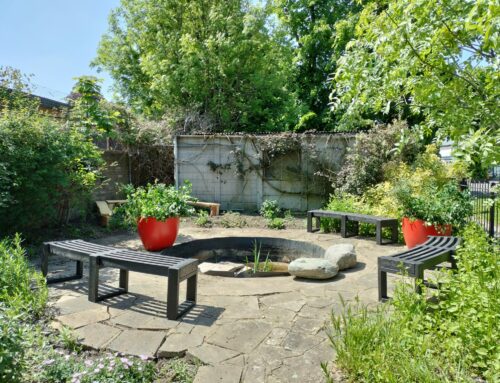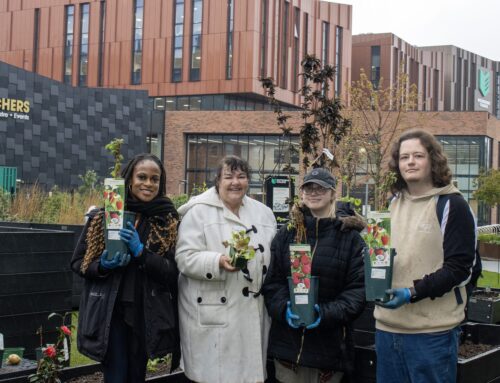Protecting and preserving meadows is definitely something that can help with the fight against climate change. It’s amazing when a project starts from a great bunch of local residents wanting to preserve a piece of nature close to their home. It’s even better when that project generates a more substantial support system and a monetary national trust award to keep it going. This is just a short summary of what is happening up at High Hirst WoodMeadow in Hebden Bridge and we couldn’t be more excited to play our part in it by supplying our Hebden Grid-X support squares that help with mud control and keeping the natural landscape intact.
Meadows are not just a pretty sight but serve as a valuable ecosystem to a wide variety of wildlife species such as insects, birds, mammals, and herbivores. David Attenborough mentioned on the BBC series Save the isles that, “97 percent of wildflower meadows have been lost since the 1930s.” As the global population continues to grow, development and industrialization have threatened their existence.
In this blog post, we’ll catch up with High Hirst WoodMeadow Project volunteer representative, Neil Diment to learn more about the Protection of High Hirst Meadow and also delve into why it is crucial to protect and preserve meadows for the sake of our environment, ecosystem, and overall well-being.
High Hirst WoodMeadow in Hebden is a very significant UK meadow as it is home to some of the rarest fungi in the world. Mr Neil Diment, stated that “We have discovered that this meadow grows threatened species of fungi. This is truly remarkable and is why we feel the need to keep it going and protect it. So, we will continue to use the land in a traditional way, having cattle and sheep graze it during the correct times and planting other trees to build a diverse natural landscape.”

With the increasing foot traffic of the meadow and the various volunteer groups coming to help with the project, the land has taken a bit of wear and tear which is something that the project team wants to try and prevent, especially when it gets rainy and wet. So, the Hebden X-Grids helps control the mud excess during the wet periods and can still support and preserve the natural soil and meadow growth. Diment states that with the x-grids people are able to enjoy the meadow with less mud. He says, “The support from the local community has been phenomenal as we have had many volunteer groups contributing to the land. It has become a lovely place for local residents and visitors to enjoy.”


Below we share some quick facts around why it is crucial to preserve and protect our meadows.
1. Preserving biodiversity
Meadows are one of the few habitats where abundant biodiversity thrives. It is home to a wide range of wildlife species, many of which are now considered endangered or threatened. These natural lands have been identified as hotspots for biodiversity in many regions, making it crucial to establish measures for their protection. With proper conservation, they can provide vital benefits, including pollinator habitats, improved soil health, and acting as carbon sinks. Therefore, we must conserve these vital areas, if we are to safeguard biodiversity for current and future generations.
2. Restoration of natural landscapes
High Hurst Meadow in Hebden is a very significant UK meadow as it is home to some of the rarest fungi in the world. Diment stated that “We have discovered that this meadow grows threatened species of fungi. This is truly remarkable and is why we feel the need to keep it going and protect it. So, we will continue to use the land in a traditional way, having cattle and sheep graze it during the correct times and planting other trees to build a diverse natural landscape.”
With the increasing foot traffic of the meadow and the various volunteer groups coming to help with the project, the land has taken a bit of wear and tear which is something that the project team wants to try and prevent, especially when it gets rainy and wet. So, the Hebden X-Grids helps control the mud excess during the wet periods and can still support and preserve the natural soil and meadow growth. Diment states that with the x-grids people are able to enjoy the meadow with less mud. He says, “The support from the local community has been phenomenal as we have had many volunteer groups contributing to the land. It has become a lovely place for local residents and visitors to enjoy.” Clearing forests and degrading land is a significant contributor to climate change. By protecting meadows, we contribute to the restoration of the natural landscapes, which aids in the mitigation of global warming. It is estimated that restoring and protecting our meadows could support the offset of hundreds of thousands of tons of carbon each year. In today’s world, it is more important than ever to establish effective ways of reducing our carbon footprint, and the preservation of meadows is one such solution.
3. Provide Environmental and Economic Benefits
Meadows offer essential environmental benefits that provide services to both humans and wildlife. These include carbon sequestration, natural flood control, and soil erosion prevention, which help maintain a clean water supply. In turn, clean water can provide economic benefits to communities through recreation, tourism, and agriculture. Clean water supports fisheries and wetlands, providing economic production values from aesthetic and recreational services. Besides, meadows are also aesthetically pleasing and provide a peaceful natural environment that benefits community well-being.
4. Preserve Cultural Heritage
Meadows play a significant role in shaping how cultures, communities, and individuals perceive the world around them. Traditional crafts, agriculture, and local folklore are closely tied to the land, and meadow habitats reflect these connections. They serve as a reminder of our cultural heritage and provide a sense of place and identity. Meadows are also often associated with wildlife and indigenous plant species, and the preservation of these can help preserve cultural diversity.
5. Education and Scientific Research
Meadows provide a unique environment for scientific research and education, providing opportunities for environmental learning and biodiversity study. It offers opportunities for scientific discovery and the popularization of natural science. Through research, we can improve our understanding of the environmental effects of human activities and develop ways to mitigate them. Meadows are fantastic outdoor classrooms for educating children and adults alike, raising awareness and encouraging hands-on learning.
The importance of protecting and preserving meadows cannot be overstated. From providing essential environmental and economic benefits, conserving biodiversity, to preserving cultural heritage, these natural spaces provide a wealth of benefits that contribute to the well-being of humanity and the environment. It is, therefore, vital that we protect and preserve these habitats for future generations. As councils, we have a duty to protect our environment and environment, and protect our meadows. The preservation and maintenance of these valuable habitats must become a priority in our decision-making, conservation, and education.
You can learn more about the biodiversity life up at High Hurst Meadow here. If you are interested in following their project they are very active on Facebook.
For more information on the Hebden X-Grids and other projects that the Grids have been used for please contact us.












